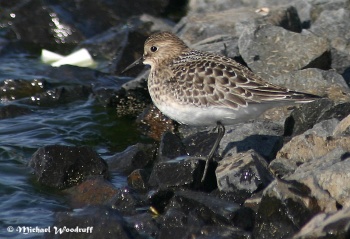- Calidris bairdii
Identification
14-17.5cm
Breeding Adult
- Gray-buff upperparts with 'scaly' appearance
- Whitish underparts
- Brownish breast
- Wing tips extend well past tail
- Black rump
- Narrow, fine-tipped bill
- Pale supercillium
Similar Species
Compared to most other species, look for very long wings creating an elongated profile. This is to some extent shared with Sanderling and White-rumped Sandpiper, and especially compared to the latter, look for all black, straighter bill and shorter legs.
Distribution
Breeds in north-east Siberia on Wrangel Island and the Chukotski Peninsula and across northern North America to Greenland.
In winter found in South America from southern Ecuador to Tierra del Fuego. Main migratory route in autumn is via the Great Plains in late July-August, juveniles migrate rather later and sometimes wander to eastern Canada. Spring movement across North America is mainly in April-early May, again most travel through the interior.
In the Western Palearctic recorded in many European countries north to Iceland, Scandinavia and Poland and south to Greece, also on the Azores.
However, most records come from Britain (c.170) where now up to 6 are recorded annually, mainly in July-October and very occasionally in spring. Most occur in the south-west but there have been many east coast records, suggesting that some may arrive from the east.
Taxonomy
This is a monotypic species[1].
Habitat
Usually seen on freshwater marshes, riverbanks and lakesides rather than coastal habitats but also on coastal and brackish marshes and adjacent grassland.
Behaviour
Breeding
They nest on the ground, usually in dry locations with low vegetation.
Diet
The diet includes insects and small crustaceans.
Vocalisation
Call: a purring churrut
References
- Clements, J. F., T. S. Schulenberg, M. J. Iliff, B.L. Sullivan, C. L. Wood, and D. Roberson. 2013. The eBird/Clements checklist of birds of the world: Version 6.8., with updates to August 2013. Downloaded from http://www.birds.cornell.edu/clementschecklist/download/
- Collins Field Guide 5th Edition
- Collins Bird Guide ISBN 0 00 219728 6
- USGS
- Wikipedia
Recommended Citation
- BirdForum Opus contributors. (2024) Baird's Sandpiper. In: BirdForum, the forum for wild birds and birding. Retrieved 26 April 2024 from https://www.birdforum.net/opus/Baird%27s_Sandpiper
External Links





